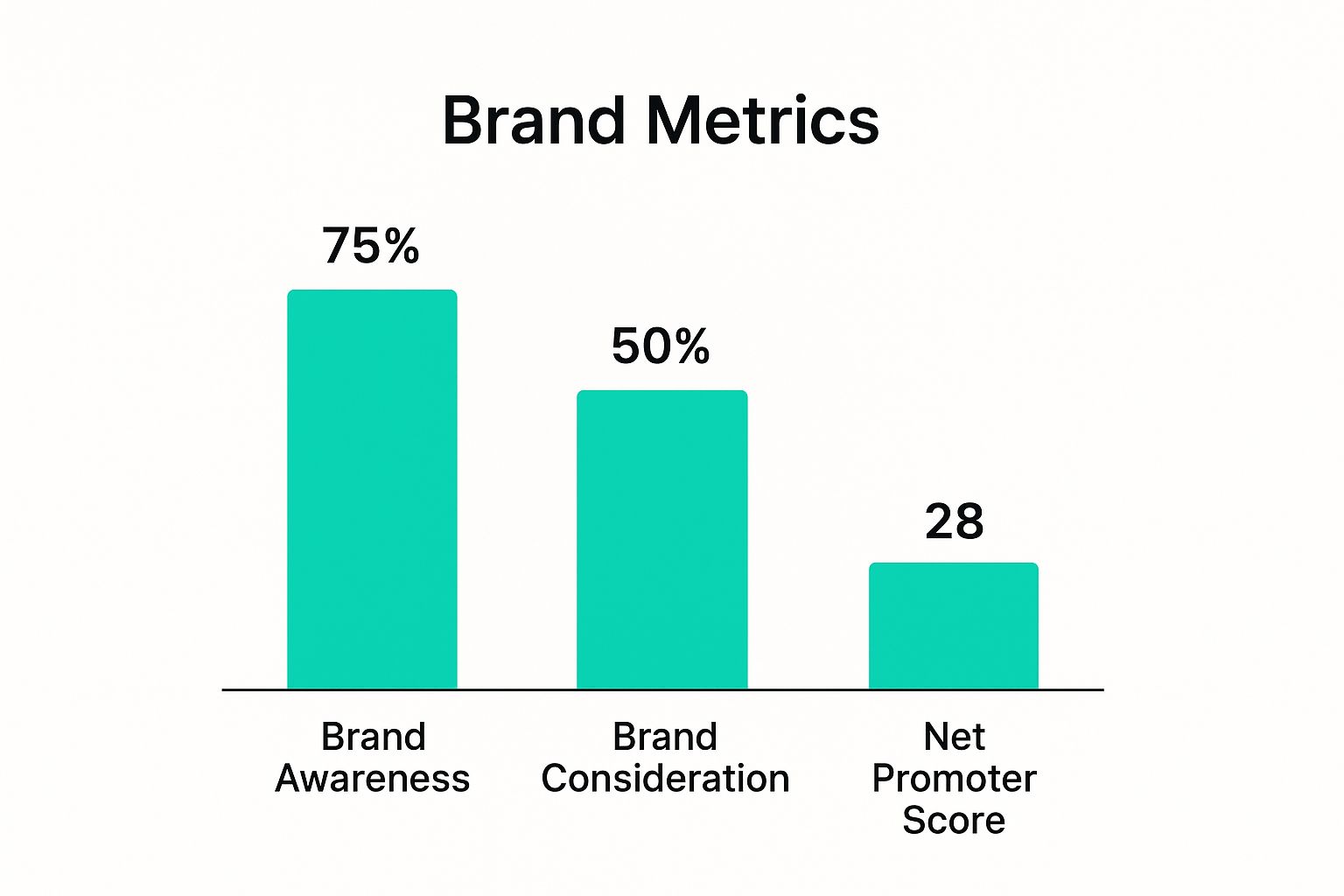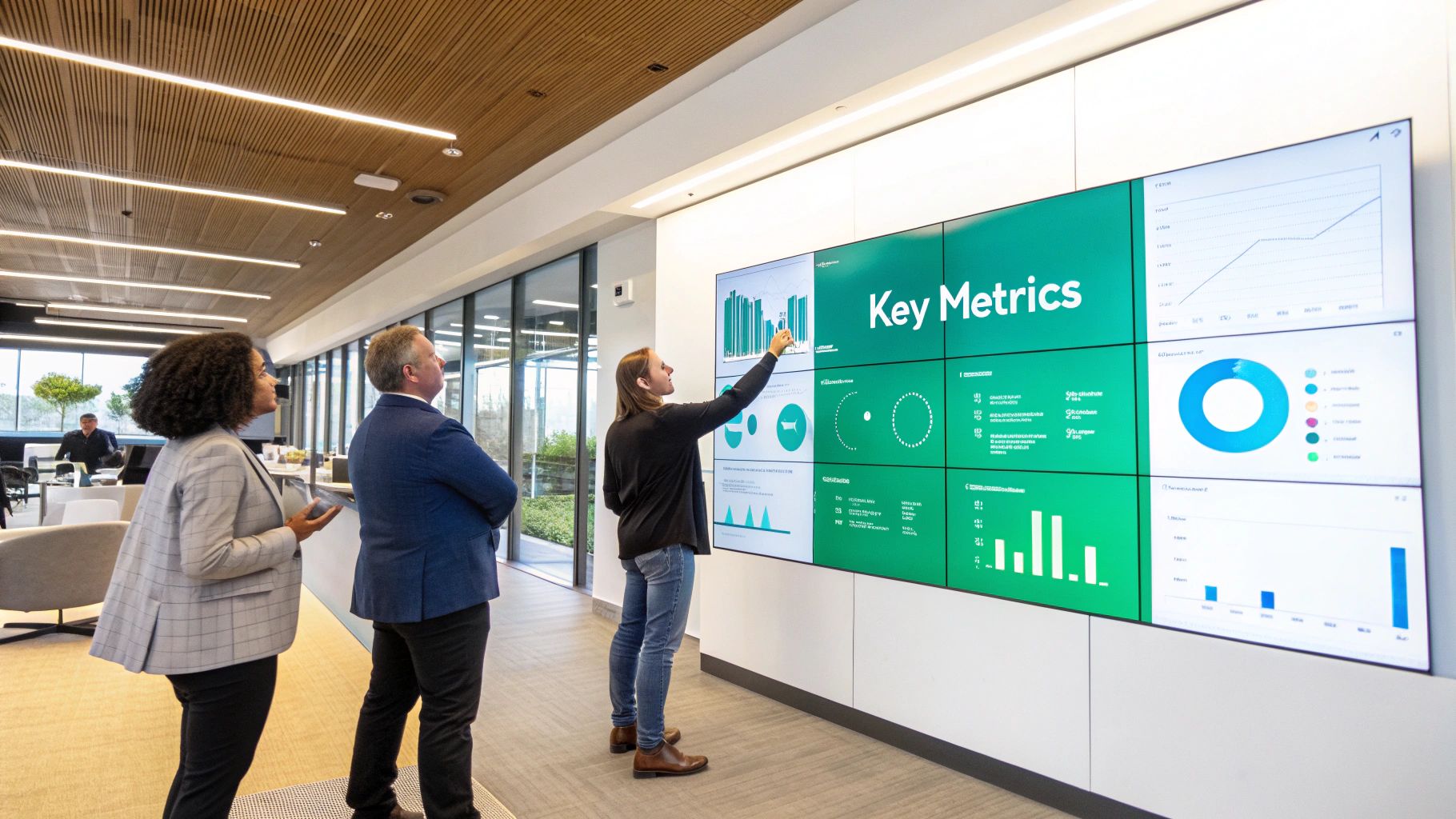Your Guide to Brand Health Tracking and Its Metrics
Brand health tracking is simply the practice of keeping a constant eye on how people see your brand. Think of it as a continuous check-up that measures vital signs like awareness, perception, and loyalty to understand your brand's standing in the market. This ongoing feedback loop helps you spot trouble early and make smarter, data-backed decisions.
Decoding Your Brand's Vital Signs
Picture your brand as a living, breathing thing. Just like a person, it has its good days and bad days. You wouldn't rely on a single, annual doctor's visit to know if you're healthy, right? You'd miss developing issues. Instead, a fitness tracker gives you constant feedback on your heart rate, sleep, and activity levels.
Brand health tracking is that fitness tracker for your brand. It’s a huge leap from the old way of doing things, like a single quarterly survey. We're moving away from static snapshots and into a world of dynamic, real-time monitoring.
This shift is more important than ever. Public opinion can turn on a dime, influenced by anything from a competitor's new ad campaign to a viral social media post. Relying on old data is like trying to drive down a busy highway by only looking in your rearview mirror—you know where you’ve been, but you have no idea what’s happening right in front of you.
The Power of Continuous Monitoring
Adopting an always-on approach to brand health gives you a real competitive edge. Instead of scrambling to fix problems weeks or even months after they’ve taken hold, you can respond the moment you see sentiment start to shift. That kind of agility is what protects your brand's reputation and solidifies its place in the market.
With continuous monitoring, you can get immediate answers to critical questions:
- Is our latest marketing campaign actually connecting with our target audience?
- How is that new product from our competitor impacting how people see us?
- Are the online conversations about our brand getting better or worse?
By constantly listening to the market's pulse, you're not just collecting data; you're gathering intelligence. This intelligence gives every part of your business—from marketing and sales to product development and customer support—the power to align with what your customers are really thinking.
From Reactive to Proactive Strategy
Today's fast-paced environment demands this kind of vigilance. As we go deeper into this decade, depending on an ongoing model for brand health will become the standard. Sudden shifts in what consumers think can wipe out brand equity in a flash. You can find more great analysis on how brand health provides a competitive edge on Dynata.com.
When you put a solid tracking program in place, you stop playing defense and start playing offense. Your brand management moves from a reactive, damage-control function to a proactive, strategic powerhouse. You don’t just diagnose problems; you start to anticipate them. That kind of foresight is what builds a resilient, adaptable brand that can thrive no matter what the market throws at it, setting you up for real, sustainable growth.
The Core Metrics You Must Measure for Brand Health
To get a real handle on your brand's health, you need to look beyond the vanity metrics. It’s about digging into the numbers that show you how your audience really thinks and feels about you. These core metrics are like your brand's vital signs, giving you a clear, multi-dimensional picture of where you stand in the market.
Think of them less as individual data points and more as interconnected signals. Together, they tell the full story of your brand’s performance. Each one answers a critical question: Do people know we exist? Do they like what we’re about? And will they pick us over the competition? Answering these questions means getting smart about measurement, pulling from different data sources to build a picture you can trust.
Brand Awareness: Your Place in the Public Mind
Brand awareness is the bedrock of brand health. It’s simple: how well does your target audience recognize and remember you? If people don’t know you exist, they can’t buy from you. It’s the first and most important hurdle to clear.
This metric usually breaks down into two parts:
- Aided Awareness: This is when someone recognizes your brand after a little nudge, like seeing your logo or hearing your name in a list.
- Unaided Awareness (Top-of-Mind): This is the gold standard. It’s when someone names your brand without any prompting when asked about a category. That signals a strong mental connection.
Just look at a globally recognized brand like McDonald's. A 2023 study found that 94% of people could identify the company just by seeing its 'Golden Arches' logo, without even the brand name attached. That kind of powerful recognition comes from decades of consistent marketing and visibility, which is why tracking this metric is so essential for staying competitive.
Brand Perception: What Your Name Evokes
Awareness tells you if people know who you are, but brand perception tells you what they think and feel when they hear your name. This is all about the associations, feelings, and beliefs tied to your brand. Are you seen as innovative? Reliable? A good value? Or maybe a bit old-fashioned?
Perception is shaped by every single interaction a customer has with you—from your ads and product quality to customer service calls and online reviews. Tracking it involves a lot of sentiment analysis, which is just a fancy way of saying you’re listening to the emotional tone of conversations about your brand. A sudden dip in sentiment can be the first warning sign of a reputation crisis brewing.
Monitoring brand perception is like listening to the market's subconscious. It uncovers the unspoken truths about your reputation, revealing the gap between the brand identity you promote and the brand image that actually exists in the minds of consumers.
The infographic below shows how all these key metrics—awareness, consideration, and advocacy—fit together to give you a quick snapshot of a brand’s health.

This chart shows a healthy progression from awareness all the way to advocacy, with a strong Net Promoter Score that suggests customers aren't just buying—they’re happy to recommend the brand to others.
Purchase Intent and Customer Satisfaction
At the end of the day, good brand health has to translate into business results. Purchase intent measures how likely a consumer is to buy your product or service in the future. It’s a forward-looking metric that directly connects how people feel about your brand to your potential revenue. High purchase intent is a great sign that your marketing is hitting the mark.
Closely related is customer satisfaction, which tells you how well your products or services are living up to expectations after the sale. Happy customers are far more likely to come back and become advocates for your brand. If you want to dive deeper into tracking customer sentiment, check out this practical guide to measuring customer satisfaction for some solid methodologies.
Tracking these metrics usually involves a mix of methods:
- Surveys: Directly asking customers how likely they are to purchase or how satisfied they are.
- Behavioral Data: Analyzing actions on your website, like adding items to a cart or making repeat visits.
- Social Listening: Finding conversations where people are talking about buying a product in your category.
By consistently measuring awareness, perception, and intent, you create a solid framework for your brand health tracking program. This gives you the power to spot weaknesses, double down on what’s working, and strategically guide your brand toward real, sustainable growth.
Proven Methods for Tracking Your Brand Health

Knowing what to measure is one thing, but figuring out how to get that data is a whole different ballgame. The methods you pick will dictate how fast you get insights and how deep they go, which directly impacts your ability to respond to shifts in the market. A solid strategy doesn't just stick to one technique; it blends a few to paint a complete picture of your brand.
Think of it like a doctor's check-up. They don't just use a stethoscope. They might also run an X-ray or do blood work because each tool provides a different piece of the puzzle. Combining old-school tracking methods with modern, real-time listening gives you that same comprehensive view of your brand’s overall condition.
Traditional Data Collection Methods
For years, brands have relied on asking customers for feedback directly. These tried-and-true methods are fantastic for gathering structured data and setting performance benchmarks over time. The only catch? They usually come with a bit of a time lag.
Here are the classics:
- Surveys (NPS, CSAT): These are your direct lines to the customer. Net Promoter Score (NPS) and Customer Satisfaction (CSAT) surveys are straightforward ways to ask people how they feel, giving you hard numbers on loyalty and happiness.
- Focus Groups: Getting a small, hand-picked group of consumers in a room for a guided chat can uncover some incredibly deep insights. This is where you find out the "why" behind your survey scores and hear opinions in your customers' own words.
These methods are valuable, but they only give you a snapshot in time. A survey you ran in January won’t tell you anything about a major competitor launch that shook things up in February. That’s why you need to pair them with what’s happening right now.
Digital-First Real-Time Monitoring
The internet is basically one giant, non-stop focus group where customers share their raw, unfiltered thoughts every second of every day. Modern brand health tracking plugs directly into this firehose of data, giving you immediate, actionable insights. It’s less about asking people for their opinion and more about listening to what they’re already saying.
The real power here comes from monitoring online conversations to understand what people are saying organically. This is where you find out what your brand's reputation really is out in the wild.
Modern tracking methods shift the focus from periodic check-ins to continuous listening. Instead of asking for feedback, you analyze the feedback that is already being shared freely across digital channels, giving you a more authentic and timely understanding of brand perception.
Social Media Listening and Sentiment Analysis
Social media listening is all about keeping an eye on platforms like X, Reddit, and LinkedIn for mentions of your brand, your competitors, or key industry terms. It’s not just about counting how many times you’re mentioned; it’s about understanding the feeling and context behind those conversations. Having an effective strategy for social media reputation monitoring is absolutely essential here.
This is where sentiment analysis comes in handy. Smart tools use AI to scan the language in posts and tag them as positive, negative, or neutral. A sudden spike in negative comments could be the first sign of a PR fire, while a wave of positive chatter around a new feature tells you you’re on the right track.
For example, a gaming company might see a sudden flood of negative posts on Reddit after a software update. By catching this early through social listening, they can jump on the bug and fix it before it blows up into a massive reputation problem. That kind of proactive move is only possible when you have real-time data.
Search Trend Analysis
Another incredibly powerful digital method is digging into search data. Tools like Google Trends show you what your audience is curious about. A jump in searches for your brand name is a good sign of growing awareness, but the real gold is in the specific things people are typing into that search bar.
Are people searching for "[Your Brand] vs. [Competitor]"? That tells you they’re in the middle of making a buying decision. Are they searching for "[Your Brand] problems"? That could be a red flag for a product issue that needs your attention.
By watching these trends, you get a direct window into the organic interests and worries of your potential customers. When you combine this intel with social listening and traditional surveys, you create a truly powerful framework for brand health tracking.
How Technology Delivers Real-Time Brand Insights

Old-school methods like surveys and focus groups give you deep insights, but they're slow. By the time the report hits your desk, the market has already moved on. Technology changes the game, turning brand health tracking from a look in the rearview mirror to a live, forward-looking strategy.
Think of it like trying to steer a ship with a map that’s only updated every three months. You’d completely miss the sudden storms or changing currents. Technology is your live GPS and weather radar, helping you navigate the shifting waters of public opinion in real time.
So, how does it work? It all comes down to Artificial Intelligence (AI) and specialized monitoring platforms. These systems scan the entire internet—social media, news, forums, reviews—and make sense of the noise at a scale no human team ever could. It gives you a constant pulse on how your brand is doing, right now.
The Role of AI in Uncovering Insights
AI is the engine driving modern brand health tracking. It automates the massive job of listening to and actually understanding millions of online conversations every single day. AI doesn't just count how many times your brand is mentioned; it digs into the context and emotion to give you a much richer picture.
It does this through a few key capabilities:
- Natural Language Processing (NLP): This is how machines learn to read and understand human language. NLP spots not only your brand name but also related topics, products, or even competitors being discussed in the same breath.
- Sentiment Analysis: Going a step further, AI figures out the emotional tone of a conversation—is it positive, negative, or just neutral? A sudden spike in negative sentiment is your early warning system for a PR firestorm. With research showing 54% of customers would ditch a brand after just one bad experience, spotting this stuff early is critical.
- Trend Identification: By crunching data over time, AI spots patterns before they go mainstream. This could be a new feature everyone is asking for, a nagging complaint about a product, or a competitor’s campaign that’s starting to catch on.
AI is like a tireless digital anthropologist, sifting through millions of conversations to find the signal in the noise. It helps you understand not just what people are saying, but how they feel and why their opinions are shifting.
This kind of automated analysis lets your team move from just watching mentions to genuinely understanding them. It turns a flood of raw data into smart, strategic decisions. For a deeper look at the tools that make this happen, check out this excellent guide to brand tracking software.
Integrated Dashboards and Automated Alerts
The other huge contribution from technology is putting all this information in one easy-to-use place. Platforms like Intently pull data from social media, news sites, and review platforms into a single dashboard with clear, simple visuals.
Instead of drowning in spreadsheets, brand managers can see all their key metrics at a glance. Charts and graphs make it easy to track performance over time and spot connections, like how a marketing campaign affected brand sentiment or how your share of voice stacks up against the competition.
These platforms also give you automated alerts. You can set up triggers for specific events, like:
- A sudden surge in brand mentions
- A major drop in your sentiment score
- A key influencer talking about your brand
- A competitor launching a new product
These real-time notifications, sent straight to your Slack or email, mean you never miss a critical moment. You can jump on an issue immediately, whether that’s helping an unhappy customer, amplifying a glowing review, or responding to a competitor’s move.
To see how a platform like this can pull everything together for your team, you can book a demo with Intently and experience real-time monitoring firsthand. This is the advantage that defines modern, effective brand health tracking.
Best Practices for a Successful Tracking Program
A powerful brand health tracking program doesn't just happen. It's built with a clear blueprint and a commitment to consistent, strategic action. Think of it like building a house—you need to start with a solid foundation. That means clear goals, the right tools, and a deep understanding of who you're talking to.
Without this structure, you risk collecting a mountain of data that tells you nothing useful. The point isn't just to measure for the sake of measuring; it's to gather real intelligence that guides your brand's growth and protects its reputation. Following these practices ensures your efforts turn into real business impact.
Define Clear Objectives from Day One
Before you track a single metric, you have to ask the most important question: "What are we trying to achieve?" Your objectives will shape every other decision you make, from the metrics you watch to the tools you choose. Are you trying to steal market share from a key competitor? Or is your main goal to improve customer loyalty and cut down on churn?
Vague goals like "improve brand health" just won't cut it. You have to get specific. Your objectives should be measurable and tied directly to business outcomes.
- Goal Example 1: Increase unaided brand awareness among Gen Z consumers by 15% within the next year.
- Goal Example 2: Improve our Net Promoter Score (NPS) from +20 to +35 over the next six months.
- Goal Example 3: Reduce negative social media sentiment by 50% following our next product launch.
These clear targets give your program a direction and make it easy to know if you're winning.
Establish a Baseline and Track Consistently
You can't know if you're making progress if you don't know where you started. The very first step in any tracking program is to establish a baseline. This is your initial snapshot of all your key metrics before you roll out any new strategies. It’s the "before" picture that gives all your future data context.
Once your baseline is set, consistency is everything. Brand health is a long-term game, and its real value comes from spotting trends over time. Sporadic check-ins won't reveal the subtle shifts in perception that could signal a looming crisis or a budding opportunity. Choose a tracking frequency that makes sense for your industry and stick to it.
"A baseline is your brand's starting line. Without it, you're running a race with no idea of how far you've come. Consistent tracking is what keeps you on pace, allowing you to see progress, spot deviations, and make adjustments before you go off course."
This consistent rhythm helps you connect changes in your metrics to specific events, like a new ad campaign or a competitor's price drop, giving you a much clearer picture of cause and effect.
Segment Your Audience for Deeper Insights
Your audience is not a monolith. Different groups of people will see your brand in unique ways, and averaging them all together can hide critical insights. Audience segmentation is simply the practice of breaking down your data by specific demographics, locations, or behaviors.
This allows you to answer much more specific questions:
- Do younger customers see our brand differently than older ones?
- Is our brand perception stronger in urban areas than in rural ones?
- How does sentiment differ between new customers and long-time loyalists?
By segmenting your data, you can uncover hidden pain points or identify your most passionate fans. This granular view helps you tailor your marketing messages and product improvements far more effectively. Of course, any data collected must be handled with care, so it's important to be familiar with our approach to customer data privacy. This ensures that while you gain insights, you also maintain trust.
The consumer electronics space offers a great parallel. The global fitness tracker market, projected to hit USD 156.5 billion by 2031, thrives on understanding different user segments—from serious athletes to casual users focused on daily wellness. Brands succeed by tailoring products and messaging to these specific groups. Find out more about how consumer trends are driving this growth in this fitness tracker market report.
Got Questions About Brand Health Tracking?
Diving into brand health tracking for the first time usually brings up a few common questions. It’s one thing to understand the concept, but it's another to figure out the practical side of getting a program up and running. Let’s clear up some of the most frequent queries.
One of the first things people ask is about timing. How often should you actually check in on your brand's health? There’s no single right answer here—it really depends on how fast your industry moves. For fast-paced sectors like tech or retail, you’ll want continuous, "always-on" tracking with tools like social listening. For the big-picture metrics like brand awareness, a quarterly or even bi-annual survey might be plenty.
The most important thing? Consistency. Sticking to a schedule is what lets you spot trends and see how your brand is performing over time.
Another big question is always about the budget, especially for smaller companies.
Can Small Businesses Afford This?
Absolutely. You don't need a massive budget to get started. While big companies might invest in expensive, all-in-one platforms, smaller businesses can get fantastic results with free or low-cost tools.
Here’s how you can start without breaking the bank:
- Google Alerts is a great, free way to keep an eye on brand mentions across the web.
- Built-in social media analytics on platforms like LinkedIn or X can tell you a lot about engagement and sentiment.
- Simple customer surveys using tools like Google Forms are perfect for gathering direct feedback.
The goal is to build a consistent process. The tools you use are less important than the routine you establish.
Finally, people often wonder what the real difference is between brand tracking and market research. They sound similar, right?
Think of it like this: market research is usually a one-off project with a clear start and end, like exploring a new market before a product launch. Brand health tracking, on the other hand, is an ongoing monitoring system. It uses market research techniques, but it does so continuously to measure change over time.
This constant monitoring gives you a dynamic, real-time view of your brand’s performance, helping you stay ahead of market shifts instead of just reacting to them.
Ready to get real-time insights and turn online conversations into actionable leads? Intently empowers you to monitor brand health and discover high-intent customers with our advanced AI-driven platform. Learn more and start your free trial.
